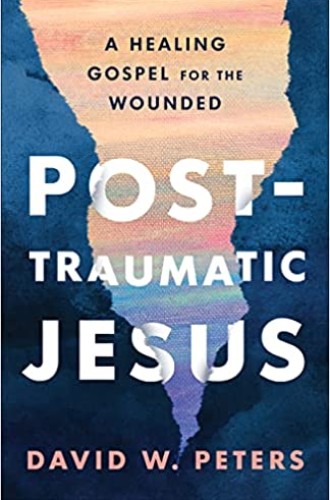Jesus is traumatized
Minister and veteran David Peters invites us to consider our own post-traumatic identities in a new light.
As a therapist specializing in trauma, I am wary of encountering it outside the office. But I was drawn into Post-Traumatic Jesus from the very first sentence, in which the author reveals himself as a missionary for a certain kind of Christ. “The only Jesus Christianity has ever known” is a post-traumatic one, declares David Peters, an Episcopal priest and Iraq War veteran. Not for him is the “gilded and gelded” Jesus who stands so distanced from the trauma of his own story and times that he alienates traumatized readers of the Bible. Instead, Peters depicts a Christ who lived and worked in the trenches of the brutal Roman Empire, intimately acquainted with suffering and never cowed by it. Peters’s Christ is one whom today’s wounded will recognize.
The book’s structure is not overly artful, but it is pragmatic and laser-focused on its thesis. Each succinct chapter presents both a trauma in the life of Jesus and a similar experience of contemporary readers. Peters deals unflinchingly with topics such as God’s silence, trans-generational trauma, abuse, and resurrecting faith after trauma. He delivers his message with piercing and explicit prose that renders some sentiments unforgettable. In a discussion of Mark 9:42, for instance, he writes, “When you’re ranting at the heavens about what [abusers] did to you, the post-traumatic Jesus doesn’t step in and ask you to tone it down a bit. He joins you in your raw anger and grief. He helps you get that giant millstone ready for the toss.” Peters stretches a few of his observations too far, leaving readers unclear about how they map onto his larger thesis, but by and large his insights resound.
Read our latest issue or browse back issues.
Another strength of the book, which sets it apart from most academic texts on this subject, is its emphasis on the personal. Trauma, because it attacks the self, can become over-coupled with identity. (Over-coupled is a clinical term that refers to a post-traumatic somatic error of linking together two feelings, events, or stimuli that should not be so closely associated.) In some cases, trauma might even supplant identity.
Peters pushes against this error, using the story of Jesus to show that we are not our traumas. He emphasizes that Jesus’ identity is “inextricably linked to his crucifixion,” designating him as “the suffering Messiah, the rejected Messiah, the murdered Messiah.” But in light of that same murdered Messiah’s resurrection, Peters invites us to consider our own post-traumatic identities in a new light. He sidesteps the objectionable blunder of suggesting we should be grateful for our wounds and instead encourages belief in restoration; he gives us permission to hope.
In addition to fostering intimacy between the reader and Jesus Christ, Peters allows himself to be known in the text. He interweaves personal stories about alcoholism, infidelity, divorce, and why he no longer keeps firearms in the house (he found his “five-year-old son holding the locked gun case . . . in his little hands”), illustrating the kind of vulnerability that a traumatized individual might feel too threatened to emulate. Vulnerability, the laying down of one’s defenses, can have unforeseen consequences, and consciously or not, Peters bears that risk in service of his mission.
The Bible is lousy with suffering, and Peters could have easily created a relationship between scriptural and contemporary trauma without involving himself. But writers are instructed to show, not tell—as are somatic trauma therapists, because it envelops the client in regulation and secure attachment, thereby accelerating healing. Peters’s approach stands to accomplish something similar.
Peters excels at conveying the interplay of human and divine trauma, but his greatest gift to readers may be the distinction he draws between what people have to offer and what Jesus does. People who are traumatized imitate Christ with the figurative stigmata they suffer. But people lack in their relationships with neighbors what Jesus shared with his celestial father: true salvation. Healing happens in relationships, but so does injury—and we humans invented the art of sin.
Peters illustrates this point with the story of Judas. As “one of the Twelve, a trusted companion of Jesus,” Judas betrays Jesus to his death, but “the betrayal depends on the friendship.” Perhaps Judas loves Jesus, like so many perpetrators of abuses large and small. We will never know, Peters admits, but from Judas’s suicide we can infer at least an awareness of his fall from grace. Peters is careful to not exonerate Judas, and he warns readers against attempting to psychoanalyze our own betrayers, lest we “join Judas in his noose.”
However, he closes the chapter with a vision of Jesus descending to hell on Holy Saturday, and “the first person he looks for is his friend Judas.” Peters muses, “Judas is that one lost sheep in the parable. There is no place we can go where Jesus will not go to find us, even hell itself.” Amen. We will never see the day when a human—the most devout priest, the most brilliant therapist—can do that. We are bereft of that kind of love. God, Peters reminds us, is not.






